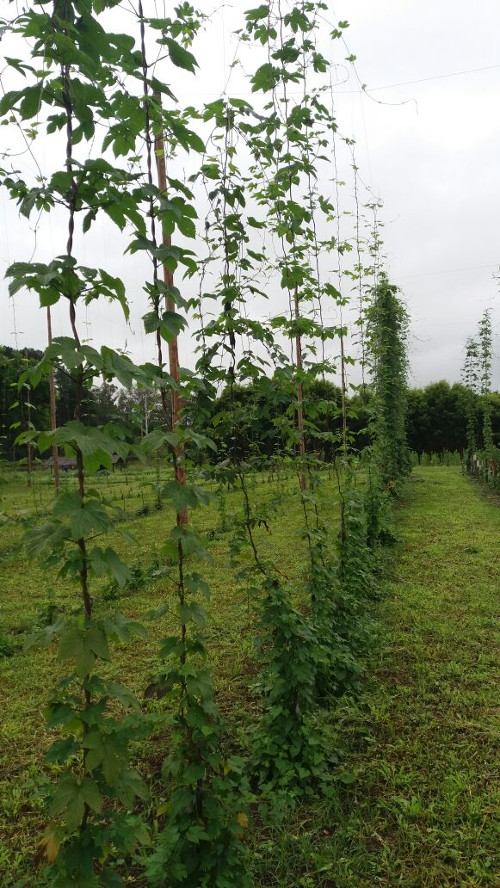Leaf area and intermittent misting on hop plants propagation by stem cuttings

Abstract
Hop (Humulus lupulus L.) is a plant with economic importance due to its use in the brewing industry. The cones produced by the species contain the main substances responsible for the beer’s bitterness and aroma. Hop plants cultivation in Brazil is still incipient and information on efficient methods for its propagation in this context are scarce. The objective of the present study was to evaluate the effect of different leaf areas (two whole leaves, two leaves in half, one whole leaf, one leaf in half and without leaves) in herbaceous stem cuttings planted in environments with and without intermittent misting. The experiment was conducted in a greenhouse in Curitiba-PR, Brazil (25º25’40 “S and 49º16’23” W). After 30 days of planting, the survival, rooting, sprouting and leaf retention percentages, roots number, average roots length and roots and sprouts dry mass were evaluated. Cuttings with one or two whole leaves and two leaves in half in the misting environment showed the highest rooting percentages (between 90.0 and 97.5%). In the without misting environment, the highest values were observed in cuttings with one or two leaves in half and one whole leaf (between 62.5 and 72.5%). Leafless cuttings had low survival percentages (2.5% in both environments). Under intermittent misting conditions it is recommended to prepare stem cuttings with one or two whole leaves and, in the absence of control over the environment humidity, cuttings with one whole leaf are recommended.
Keywords
Humulus lupulus, Chinook, Asexual reproduction, Rooting, Growth environments, Transpiration
Author Biography
Erik Nunes Gomes
Licenciado em Ciêncas Agrícolas - Instituto Federal Catarinense;
Mestrado em Agronomia/Produção Vegetal - Universidade Federal do Paraná.
Doutorado em Andamento em Agronomia/Produção Vegetal - Universidade Federal do Paraná.
References
- Almaguer, C., C. Schonberger, M. Gastl, E.K. Arendt, and T. Becker. 2014. Humulus lupulus – a story that begs to be told. A review. J. Brew. Distilling 120(4), 289-314. Doi: 10.1002/jib.160
- Amaral, G.C., L.P.D.S. Brito, R.C. Avelino, J.V.D Silva Júnior, M.Z. Beckmann-Cavalcante, and I.H.L. Cavalcante. 2012. Produção de mudas de Duranta repens L. pelo processo de estaquia. Rev. Cienc. Agr. 35(1), 134-142.
- Bona, C.M.D. and L.A. Biasi. 2010. Influence of leaf retention on cutting propagation of Lavandula dentata L. Rev. Ceres. 57(4), 526-529. Doi: 10.1590/S0034-737X2010000400014
- Braun, H., P.C. Cavatte, J.A. Teixeira do Amaral, J.F. Teixeira do Amaral, and E.F. Reis. 2010. Produção de mudas de tomateiro por estaquia: efeito do substrato e comprimento de estacas. Idesia 28(1), 9-15. Doi: 10.4067/S0718-34292010000100002
- Correia, A.C.G., A. Xavier, P.C. Dias, M. Titon, and R.C. Santana. 2015. Redução foliar em miniestacas e microestacas de clones híbridos de Eucalyptus globulus. Rev. Árvore 39(2), 295-304. Doi: 10.1590/0100-67622015000200009
- DeNoma, J.S. 2000. Humulus genetic resources: Hop. USDA ARS National Clonal Germplasm repository. USDA ARS National Clonal Germplasm Repository, Corvallis, OR.
- Dias, P.C., A. Xavier, L. Silva de Oliveira, A.C. Guieiro Correia, and G.A. Barbosa. 2015. Tipo de miniestaca e de substrato na propagação vegetativa de angico-vermelho (Anadenanthera macrocarpa (Benth.) Brenan). Cienc Flor. 25(4), 909-919. Doi: 10.5902/1980509820593
- Garbuio, C., L.A. Biasi, A.P.D.J. Kowalski, D. Signor, E.M. Machado, and C. Deschamps. 2007. Propagação por estaquia em patchouli com diferentes números de folhas e tipos de estacas. Sci. Agr. 8(4), 435-438. Doi: 10.5380/rsa.v8i4.9893
- Howard, B.H. 1965. Regeneration of the hop plant (Humulus lupulus L.) from softwood cuttings. I. the cutting and its rooting environment. J. Hort. Sci. 40(1), 181-191. Doi: 10.1080/00221589.1965.11514132
- Koetter, U. and M. Biendl. 2010. Hops (Humulus lupulus): a review of its historic and medicinal uses. J. Am. Bot. Council 87(1), 44-57.
- Lusa, M.G. and L.A. Biasi. 2011. Estaquia de Cuphea calophylla subsp. mesostemon (Koehne) Lourteig (Lythraceae). Rev. Bras. Plantas Med. 13(1), 52-57. Doi: 10.1590/S1516-05722011000100008
- Nance, M.R. and W.N. Setzer. 2011. Volatile components of aroma hops (Humulus lupulus L.) commonly used in beer brewing. J. Brew. Distilling 2(2), 16-22.
- Pacheco, J.P. and E.T.H. Franco. 2008. Substratos e estacas com e sem folhas no enraizamento de Luehea divaricata Mart. Cienc. Rural 38(7), 1900-1906. Doi: 10.1590/S0103-84782008000700015
- Pizzatto, M., A. Wagner Júnior, D. Luckmann, K. Pirola, D.A. Cassol, and S.M. Mazaro. 2011. Influência do uso de AIB, época de coleta e tamanho de estaca na propagação vegetativa de hibisco por estaquia. Rev. Ceres 58(4), 487-492. Doi: 10.1590/S0103-84782008000700015
- Santana, R.C., T.R. Dutra, J.P. Carvalho Neto, G.S. Nogueira, P.H. Grazziotti, and N.F.D. Barros Filho. 2010. Influence of leaf area reduction on clonal production of eucalyptus seedlings. Cerne 16(3), 251-257. Doi: 10.1590/S0104-77602010000300001
- Silva, F.D.A.S. and C.A.V. Azevedo. 2016. Comparison of means of agricultural experimentation data through different tests using the software Assistat. Afr. J. Agric. Res. 11(1), 3527-3531. Doi: 10.5897/AJAR2016.11522
- Silva, P.H.A. and F.C. Faria. 2008. Avaliação da intensidade de amargor e do seu princípio ativo em cervejas de diferentes características e marcas comerciais. Ciênc. Tecnol. Aliment. 28(4), 902-906. Doi: 10.1590/S0101-20612008000400021
- Solis, R., M. Pezo, G. Diaz, L. Arévalo, and D. Cachique. 2017. Vegetative propagation of Plukenetia polyadenia by cuttings: effects of leaf area and indole-3-butyric acid concentration. Braz. J. Biol. 77(3), 580-584. Doi: 10.1590/1519-6984.20415
- Sousa, C.M., R.N. Busquet, M.A.D.S. Vasconcellos, and R.M. Miranda. 2013. Effects of auxin and misting on the rooting of herbaceous and hardwood cuttings from the fig tree. Rev. Cienc. Agron. 44(2), 334-338. Doi: 10.1590/S1806-66902013000200016
